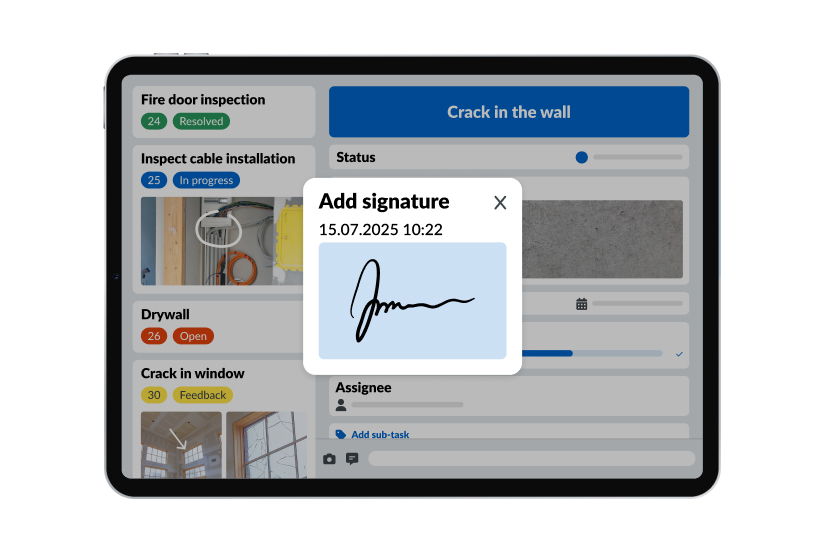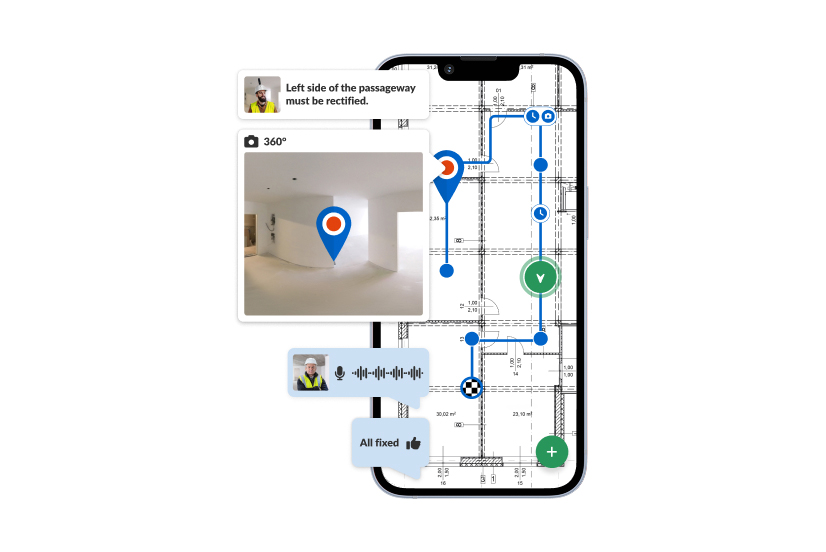Compliance failures on construction sites are costly. A missed inspection, outdated certification, or undocumented safety check can trigger rework, delays, and even legal or insurance penalties. For general contractors, these gaps don’t just add risk—they drive up project costs and damage subcontractor relationships.
Contractor compliance management software helps prevent these failures by centralizing documentation, standardizing safety processes, and providing audit-ready records. Unlike legacy contractor management solutions, modern tools focus on both efficiency and accountability, ensuring subcontractors meet requirements in practice, not just on paper.
While specialized contractor compliance software tracks licenses and renewals, PlanRadar enables compliance in the field. With mobile checklists, photo documentation, QR/NFC tags, and instant reporting, general contractors can prove subcontractors follow protocols daily—reducing risk, cutting rework, and keeping projects on schedule.

The Two Sides of Contractor Compliance
Contractor compliance has two dimensions:
1️⃣ Upfront compliance – verifying licenses, insurance, and certifications before subcontractors ever set foot on site. This prevents unqualified contractors from being hired in the first place. Many GCs now use subcontractor compliance management software to streamline prequalification and ensure documentation is complete before work begins.
2️⃣ Field compliance – ensuring subcontractors actually follow safety and quality protocols during daily work. This is where most failures—and costly rework—occur.
Traditional contractor compliance management software focuses heavily on upfront vetting and document tracking. But for general contractors, real risk control comes from field compliance, where tasks must be completed, inspections documented, and safety requirements enforced on the ground.
PlanRadar complements dedicated compliance systems by closing this gap. Its mobile checklists, task assignments, and audit-ready reports give GCs visibility into subcontractor performance in real time—ensuring compliance doesn’t stop at prequalification but is proven on site.
Why Field Compliance Is Critical for General Contractors
Reduce rework: Non-compliant work often leads to errors that must be redone. A missed inspection, skipped checklist, or unqualified worker on site can result in costly do-overs and schedule slippage.
Control project costs: Compliance failures trigger more than rework—they can also cause penalties, insurance claims, and contractual disputes. Each incident adds unplanned costs and strains project budgets. Recent regulations such as the Build America, Buy America Act (BABAA) highlight this risk. Contractors on federally funded projects must now prove materials meet domestic sourcing requirements, with non-compliance exposing them to penalties under the False Claims Act.
Manage subcontractors effectively: Large projects involve dozens of subcontractors, each with their own processes and standards. Without consistent oversight, accountability breaks down and compliance gaps multiply, increasing the likelihood of incidents and delays.
Benefits of Field-Level Contractor Compliance Software
Relying on manual processes to manage subcontractor compliance leaves room for error, missed deadlines, and costly disputes. Software streamlines these processes and gives general contractors greater control.
| Area | Manual Process | With Contractor Compliance Management Software |
| Risk & Liability | Paper-based records can be lost or tampered with. Compliance gaps often go unnoticed until too late. | Digital, tamper-proof records created with contractor safety management software reduce liability and prove due diligence instantly. |
| Safety & Quality | Inconsistent checklists and oversight result in unsafe practices and poor workmanship. | Standardized digital checklists in contractor safety compliance software ensure safety protocols and quality standards are consistently met. |
| Efficiency | Time wasted chasing paperwork, phone calls, and email confirmations. | Automated reminders, centralized data, and instant reporting save hours each week. |
| Subcontractor Management | Limited visibility into subcontractor compliance, inconsistent accountability. | Real-time dashboards, task assignments, and digital sign-offs keep subs aligned and accountable. |
| Cost Control | Frequent rework, fines, and delays drive up budgets. | Early detection of compliance gaps prevents overruns and keeps projects on track, with built-in contract compliance tracking and reporting protecting against disputes. |
How Software Ensures Field Compliance — and How PlanRadar Makes It Work
Ensuring contractor compliance on the jobsite requires more than clipboards and spreadsheets. Modern contractor compliance management software provides the tools general contractors need to standardize processes, monitor subcontractors, and create audit-ready records. Key capabilities include:
📃 Digital checklists & forms – Standardize QA/QC inspections, safety checks, and daily logs.
📷 Photo & video documentation – Capture visual proof of compliance, reducing disputes.
🔗 QR/NFC tags – Provide instant access to location-specific compliance data.
👷♀️ Real-time collaboration – Keep subcontractors aligned with updates and task confirmations.
💯 Audit-ready reporting – Generate documentation to demonstrate due diligence.
This is where PlanRadar adds value as a platform for documentation, communication, and reporting in construction and real-estate project. Instead of focusing only on certifications and renewals, PlanRadar ensures compliance is enforced and documented in the field. General contractors can move from planning to execution in five simple steps:
| Step | What You Do | How PlanRadar Helps |
| 1. Define Compliance Criteria | Standardize QA/QC, safety, and regulatory requirements. | Create customizable digital forms and checklists for specific trades, sites, or subs. |
| 2. Assign Responsibilities | Distribute tasks with clear deadlines and expectations. | Create tickets linked to plans, with attached compliance requirements. |
| 3. Capture Proof on Site | Verify subcontractor compliance during daily work. | Use the mobile app (online/offline) to complete checklists, add photos/videos, signatures, and QR/NFC-based records. |
| 4. Monitor Progress | Track compliance status across multiple subcontractors. | Real-time dashboards, similar to those in track contractor management software, highlight overdue tasks, missing data, or non-compliance issues instantly. |
| 5. Report & Share | Demonstrate due diligence to clients or regulators. | Export audit-ready, customizable reports with all supporting evidence. |
PlanRadar was built to help general contractors turn compliance from a paperwork burden into a practical, everyday workflow:
✅ Flexible compliance tools: Create digital checklists, inspection forms, and reports tailored to your safety, QA/QC, and regulatory requirements.
✅ Clear subcontractor accountability: Centralize all tasks, documents, and communications so every subcontractor knows what’s required and nothing slips through the cracks.
✅ Always available on site: Use the mobile app online or offline to capture compliance evidence—photos, videos, and signatures sync automatically when connectivity returns.
✅ Simple to adopt: With an intuitive interface, subcontractors and field teams can start documenting compliance in minutes, reducing training time.
👉 Ready to reduce rework, cut costs, and keep subcontractors compliant in the field? Book a free demo today and see how PlanRadar supports compliance on your projects.
Best Practices for Ensuring Field Compliance
Compliance software is most effective when general contractors build it into daily workflows. Here are five proven ways to get the most value:
1️⃣ Standardize digital checklists: Create software-based QA/QC and safety forms that every subcontractor must complete before tasks are signed off.
2️⃣ Require digital proof of completion: Use built-in features for photos, videos, and electronic signatures so every inspection is backed by evidence.
3️⃣ Train subcontractors on the platform: Onboard subs early, ensuring they know how to log issues, complete tasks, and upload compliance documentation.
4️⃣ Leverage real-time dashboards: Monitor compliance status daily through live dashboards instead of waiting for paper reports or end-of-week updates.
5️⃣ Automate your audit trail: Store all documentation centrally in the system to instantly generate audit-ready reports for clients, insurers, or regulators.
Contractor Compliance Software: FAQs
What is contractor compliance management software?
It’s a digital tool that helps organizations ensure subcontractors meet legal, safety, and project-specific requirements. It centralizes documents, standardizes checklists, and provides audit-ready records.
How does contractor compliance software help general contractors?
It reduces rework, controls project costs, and keeps subcontractors accountable by providing real-time visibility into compliance status and by automating documentation processes.
What is the best contractor compliance software for general contractors?
The best contractor compliance software offers mobile accessibility, customizable checklists, automated reporting, and integration with project management workflows. These features ensure subcontractors not only meet compliance requirements but also prove them in the field.
What’s the difference between contractor management solutions and compliance software?
Contractor management solutions focus broadly on scheduling, communication, and task management. Contractor compliance software is designed to enforce safety and regulatory standards, track proof, and manage compliance records. The best contractor management software now combines both—helping general contractors manage schedules, costs, and subcontractor compliance in one platform.
How can software reduce subcontractor delays and project risks?
By requiring digital proof (photos, signatures, checklists) before tasks are marked complete, software ensures work is compliant from the start—preventing costly do-overs, safety incidents, and project slowdowns.


